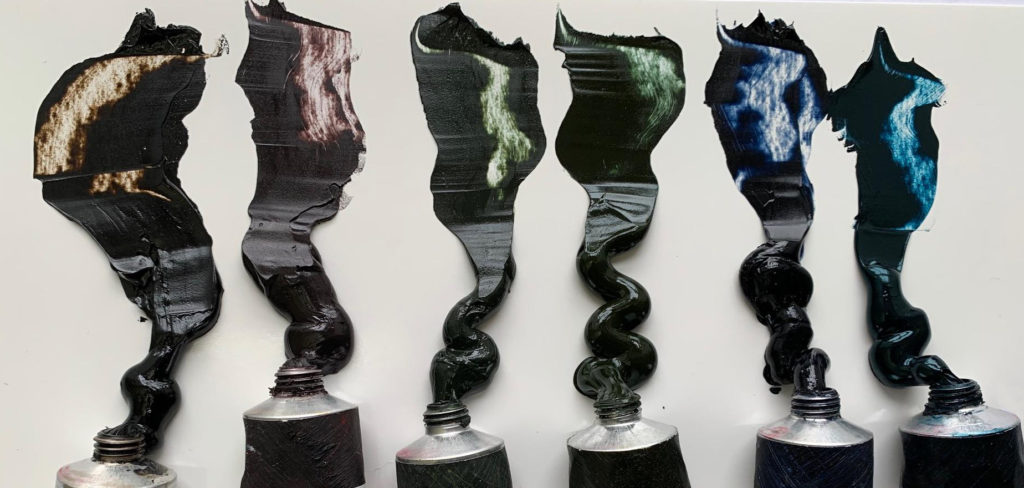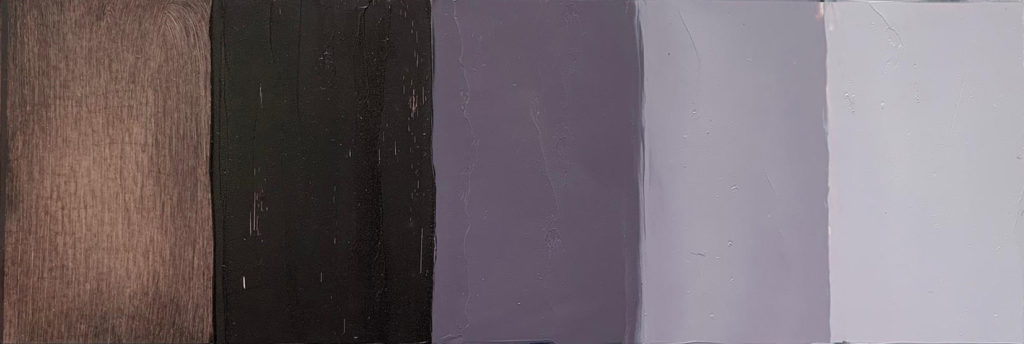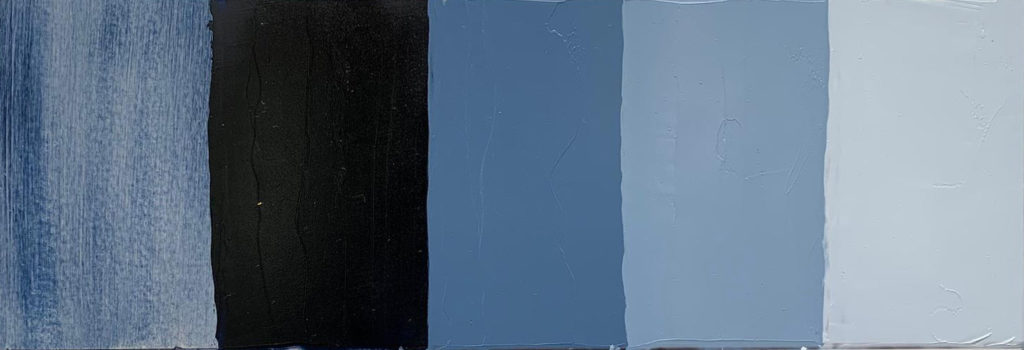
When oil painters visit our factory, we always show them these colors. The response is unanimously positive, especially from those who use darker tones or blacks in their work. Williamsburg has six chromatic darks that we want to feature in this article. These colors are all blends, containing a natural iron oxide or Ivory Black and one or more strongly colored pigments to give them their chromatic punch. When painted from the tube, they visually resemble a colorful black, but when scumbled, tinted or mixed, these darks start to show their true color! Van Dyke Brown, Payne’s Gray (Violet), Turkey Umber, Courbet Green, Payne’s Gray and Indigo are all useful additions to the palette that can be used for underpainting, to neutralize and deepen chromatic colors, replace blacks or umbers or simply function as rich colors to enliven the darker areas of a painting.
Van Dyke Brown

We have recently introduced a new formula for Van Dyke Brown that contains Ivory Black and Transparent Red Iron Oxide. Click HERE for more information on that change. It is a rich dark brown, bordering on a warm black, that can either take the place or bridge the gap between black and umber. It is semi-opaque, finely milled and fast drying. When mixed with white, it tints to a warm gray. Although semi-opaque, Van Dyke can modify transparent colors to produce translucent mixtures that can be slightly neutral with a wonderful glowing quality.
Payne’s Gray (Violet)

Payne’s Gray (Violet) is a play on traditional Payne’s Gray. Instead of Ivory Black and Ultramarine, it contains Raw Umber, Dioxazine Purple (Williamsburg’s Egyptian Violet) and Ultramarine Blue. This is a dark, smoky purple, great for neutralizing lighter mixtures or for providing the base for shadows in portraits or landscapes. Payne’s Gray (Violet) tints to make a misty dull mauve, reminiscent of pleasant looking smoke or shadowy clouds. It mixes like a weak blue. It is semi-opaque, very fine and fast drying.
Turkey Umber

Turkey Umber is a mixture of Raw Umber and Phthalo Green. It is one of those combinations that makes sense when you see it, but may not be something one would normally mix together. It is a semi-opaque, finely milled, fast-drying color that can be used in combination with an earthy red or Burnt Umber as a warm/cool underpainting palette, or used as a dark, neutral green to hold down a landscape painting. Turkey Umber is a great alternative to Raw or Burnt Umber to reduce intensity with a little bit of a twist.
Courbet Green

Calcined Yellow Ochre, Prussian Blue and Permanent Yellow Deep combine to make Courbet Green a sophisticated dark green. In masstone and undertone it appears warm throughout, but changes temperature when mixed with white. Courbet Green tints to a minty cool, bluish green. It is similar to Turkey Umber but more extreme in every way. The masstone is darker, the tinting strength is stronger and the range from warm, glowing undertone to cool tint is much more pronounced. It is semi-opaque, very fine and fast-drying.
Payne’s Gray

Payne’s Gray is a classic color made with Ultramarine Blue and Ivory Back. It is essentially a more neutral version of Ultramarine. It can be used for skies, shadows for flesh tones, as an alternative to black and so much more. It is one of those colors that once it makes its way onto the palette, becomes universal and a frequent contributor to many mixtures. It is semi-opaque, fine, and dries within a couple days.
Indigo

Raw Umber and Prussian Blue combine to make Indigo a deep greenish blue with intense tinting strength. Similar to the relationship between Courbet Green and Turkey Umber, Indigo is Payne’s Gray’s intensely chromatic counterpart. Indigo has no relationship to the natural, organic dye derived from the fermented indigo plant, except for its potent ability to stain and render things blue. This is a tempered version of Prussian Blue, making it a little easier to shift mixtures without fully taking them over, as can happen when using straight Prussian. It is semi-opaque, fine, and very fast-drying.
Chromatic darks have been an important part of the Williamsburg palette since the company’s earliest days and remain so today. There are many opportunities to employ darker tones in a variety of painting styles from portrait and plein air to abstract and non-objective. We hope you enjoy these colors, and that one or several of them make their way onto your palette. As always, if you have any questions or would like to contact our Technical Support team, simply email [email protected] or call 800-959-6543.
About Greg Watson
View all posts by Greg Watson -->Subscribe
Subscribe to the newsletter today!

These mixtures all look like really useful colors, but I am surprised you chose to name the last one Indigo. It does not look at all like the Indigo I use (in watercolors), and since that is a historical pigment I think this addition is going to confuse people……
Hello Peggy,
This color was created by Williamsburg’s founder and is part of the company’s heritage. Williamsburg Indigo uses a blend of pigments (Raw Umber and Prussian Blue) to roughly match the color of traditional indigo. Ours is definitely more intense than indigo dye. But, because dyes tend to have poor lightfastness compared to pigments, most manufacturers today use a blends to match that indigo colorspace. For example, our QoR Watercolor Indigo contains Phthalo Blue,Carbon Black and Quinacridone Violet.
If you have any other questions or comments, you can email us at [email protected]
Thanks,
Greg
I could use this colors in acrylic. Hope that it vil be developed., or vi can get the recept so that vi can make them us self.
Hello A.C.
Thank you for your comment. All of the blends in the article have the pigments listed for each color. If you have some of those colors in your studio, you can try to make small mixtures to find that colorspace, or email [email protected] for more information.
Greg
What is Calcined Yellow Ochre? And which Phthalo Green (YS or BS) was used/ thanks for all your good information Greg!
Hello Don,
Thanks for your comment. The manufacturer for the PR102 we use in Courbet Green uses the term ‘Calcined Yellow Ochre’ for their pigment, so we use the same nomenclature. Not sure why they chose to follow that naming convention. The term Calcined Natural Iron Oxide can also be used. Pigment manufacturers can heat certain pigments under specific conditions to change their value and color quality. For example, Raw and Burnt Sienna are the same pigment except one is natural and the other is calcined. The green in Turkey Umber is PG7 – Phthalo Green (Blue Shade). Raw Umber and Phthalo Green(BS)- lovely!
Greg
What are the equivalent color names in acrylic?
Hello Charles,
Thank you for your comment. Most of these colors do not have direct equivalents in the acrylic lines. The exceptions are Payne’s Gray and Van Dyke Brown, which are in both categories. The acrylic versions may be slightly different in value and saturation. The closest green mixture we have to Courbet Green is called Hookers Green Hue. It is a dark muted green that tints to a slightly cool, minty color. Jenkins Green is also in a similar color space, but it has a warmer tint.
We hope this helps!
Greg
Excellent info, thank you. I am a huge fan of Turkey Umber. It mixes well with Cad Yellow and it is the only green I don’t mix. I was not aware of Courbet Green, but will be trying it ASAP. Thank again.
Hi Mark,
You are very welcome. Thanks for letting us know you are enjoying the Turkey Umber and how you use it. We are glad to introduce you to Courbet Green – Its a real beauty! Hope it enhances your palette!
Take care,
Greg
Hi,
Do you have a chart like these ones for every color?
Hello Pablo,
We have a brush out for each color on our website, Williamsburgoils.com. You can click on the swatch in the color chart and see a brush out with each color diluted with solvent at the top, directly from the tube in the center and then tinted with white toward the bottom. We also have printed color charts with the color from the tube brushed to show the transparency or opacity. You can contact [email protected] if you are interested in a color chart.
Thanks!
Greg
I’m coming rather late to this discussion, but I’m very curious why Williamsburg’s cold black has been omitted from this lineup. That was one of the first oil paints I ever used, as part of a very limited Greek palette.
Hi Appel,
You are right! I cant remember why I left that out, other than it is somewhat similar to the Payne’s Gray. Perhaps We will do a short follow up – Mixing with Cold Black! Thanks for the reminder and hopefully folks will see your comment and look into Cold Black for use in a limited palette.
Take care!
Greg